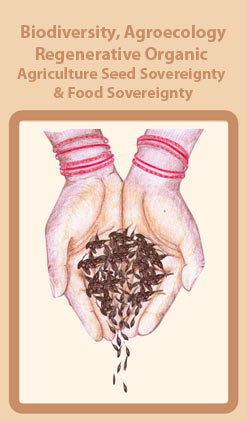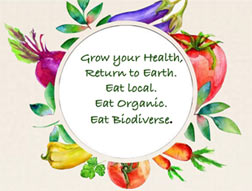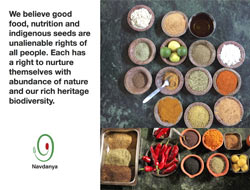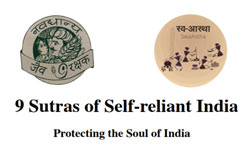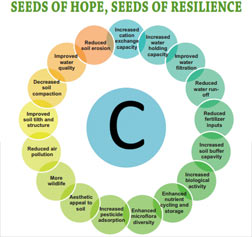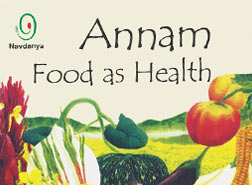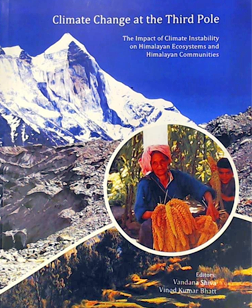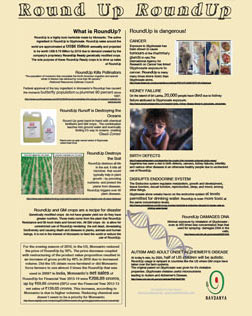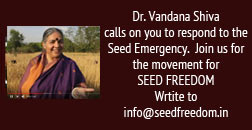The last two centuries of dependence on fossil fuels has created multiple distortions in our view of the world, of our production and consumption systems, of our ideas of efficiency and productivity, of our ideas of technological progress, of the way we produce and distribute our food.
We use more resources to produce the goods we consume, and call it more “productive”. We create more waste and more externalities that the earth and others have to bear, and we call it more “ancient”. We degrade the planet, push species to extinction at 1000 times the normal rate, we are making the planet unliveable because of climate chaos, and we call it progress.
e emissions from fossil fuel based economic activities are termed, by the scientists who have been studying climate change, as anthropogenic emissions - originating from human activity. e Intergovernmental Panel on Climate Change (IPCC) has recognised that since 1750 the net effect of human activities on the earth’s climate has been one of warning. Certainly about the anthropogenic basis for climate change has gone from greater than 66 percent to greater than 90 percent.
If no action is taken to reduce greenhouse gases, we could experience a catastrophic 4°C increase in temperatures by the end of the century.
Climate change is not just about global warming and rising temperatures. The destabilisation of the climate system is leading to the intensification of droughts, foods, cyclones and other extreme weather events. Year a er year the frequency and intensity of these extreme events is increasing. Climate Change is already a life and death issue in large parts of the world.
In 1992, at the Earth Summit, the International community adopted two major ecological principles – the precautionary principle and the polluter pays principle, and signed two legally binding agreements – e UN Convention on the Conservation of Bio- diversity,(CBD) and UN Framework Convention on Climate Change (UNFCC).
Both treaties were shaped by the emerging ecological sciences and the deepening ecology movement. one was a scientific response to the ecological impact of pollution of the atmosphere due to use of fossil fuels. e second was a scientific response to the genetic pollution caused by GMOs and the erosion of biodiversity due to the spread of industrial, chemical monocultures. Three years Rio, the UN Leipzig Conference on Plant Genetic Resources assessed that 75% biodiversity had disappeared because of the Green Revolution and Industrial farming. e FAO estimates, 70-90% of global deforestation is due to Industrial Agriculture pushing it’s monocultures further and further into forests to grow commodities for export - not for food. Disappearance of pollinators and beneficial soil organisms are other dimensions of biodiversity erosion due to industrial agriculture.
Most of mankind now lives on no more than 12 plant species, with the four biggest staple crops (wheat, rice, maize and potato) taking the lion’s share
(Esquinas Alcazar 2010). In India, rice varieties have declined from an estimated 200,000 before colonial- ism, to 30,000 in the mid 19th century with several thousand more varieties lost since the imposition of Green Revolution on India, in the 1960s. Similarly, Greece is estimated to have lost 95% of its traditional wheat varieties a er being encouraged to replace local seeds with ‘modern’ varieties developed by CIMMYT. e disappearance of this diversity in our diets has manifested in the epidemic of malnutrition, especially amongst the world’s poor. Having created the epidemic, this failed system of chemical agriculture would like to force ‘Golden Rice’ and ‘GMO Bananas’ on us under the pretext of “bio-fortication” without appropriate and adequate testing.
Crop Genetic Diversity is indispensable in providing resilience to face unpredictable environmental and climate changes and meet the needs of an ever expand ing human population.
Plant breeding has resulted in severe erosion of diversity of crop varieties. e changes in who controls seed production and seed supply have had devastating effects on genetic erosion. Either we can allow the power of diversity to enrich our soils, combat climate change and nourish us from disease to health or we can sit back and allow monocultures, chemicals and GMOs to drive humanity to extinction.
Interdisciplinary science and democratic movements created the momentum for International Environmental law. Science and Democracy continue to be the forces challenging the mindless threat to the Earth because of corporate greed.
In the case of Climate Change the key issue is reduction of emissions and strategies for adaptation. In the case of Biodiversity Conservation the key issues are Biosafety and promotion of practices that conserve Biodiversity.
Both treaties connect in agriculture, our daily bread. How we grow our food has a major impact on the health of the planet and the health of people.
Industrial agriculture is based on fossil fuels and the chemicals it uses are derived from fossil fuels. As I have mentioned in my book “Soil Not Oil” 50% of the atmospheric pollution linked to excess carbon dioxide, nitrogen oxide, methane comes from and industrial, globalised food system. A report from Grain based in Barcelona Spain in their report on Food Sovereignty concludes “that the current global food system, propelled by an increasingly powerful transnational food industry, is responsible for about half of all human produced greenhouse gas emissions: anywhere between a low of 44 per cent to a high of 57 per cent.”
Source: www.grain.org/ article/entries/5390-food- sovereignty-can-stop-climate-change-and-feed-us-all. e same fossil fuel intensive, poison intensive in-
Industrial agriculture is also destroying the biodiversity of our seeds and crops, soil biodiversity, killing pollinators, destroying water resources. It is also responsible for 75% of the disease epidemic related to bad food produced by oil.
e spread of monocultures and the increasing use of chemical fertilisers in agriculture, combined with destruction of habitats, have contributed to the loss of biodiversity. Paradoxically, this biodiversity would have helped sequester greenhouse gases.
Industrial agriculture is a major contributor to climate change because of its dependence on chemicals,
fossil fuels and on a globalised food system that requires energy intensive, long distance transport. Additionally, it is highly vulnerable to climate change as it is based on uniformity and monocultures, on centralised distribution systems, and on intensive energy and water inputs. Genetically Engineered (GE) crops aggravate all the shortcomings of industrial monoculture crops, spreading more genetic uniformity, causing genetic contamination and weakening resilience to biotic and abiotic stresses, all the while requiring more water and pesticides. GE is a false solution and a dangerous diversion from our task of mitigating climate change. e industrial agricultural system, as promoted by the current economic paradigm, has accelerated climate instability and increased food insecurity. e spread of modern, commercial agriculture has been identified as the chief contemporary cause of the loss of genetic diversity and local varieties. e impact of GE on seed diversity as well as on the overall biodiversity will be devastating. Technology present an attractive “silver-bullet” solution, but will only increase vulnerability while simultaneously undermining nature’s and farmers’ safeguards against climate chaos.
New research published on 2nd March, 2016 in e
Lancet nds that by making food less available, climate change could account for more than 500,000 human deaths by the year 2050. e researchers assumed a scenario where global air temperature in 2050 is about 2 degrees warmer than it was between 1986 and 2005. According to the research where agriculture is crippled by more drought, heat, and fooding, each person would see 3.2 percent less food on their plates every day overall. In addition, by 2050, under that same climate change scenario, we can anticipate the average person will eat 4 percent fewer fruits and vegetables.
Source: http://www.newsweek.com/climate-change- leads-500000-deaths-altering-food-production-433182.
e alternative, a biodiversity intensive, ecology intensive, localised food system, rejuvenates the health of the planet, and our health. rough biodiversity of plants zing atmospheric carbon and nitrogen, excess greenhouse gases are removed from the atmosphere where they cause pollution and climate instability, and are put in the soil where they rejuvenate fertility and produce more and healthier food.
e same food and agriculture systems that con- serve and rejuvenate biodiversity also mitigate climate change. ey contribute to health and to increased livelihoods in regenerative living economies.
People and communities everywhere are giving up poisons and adopting agroecology. They are shining from an agriculture destroying the health of the planet and our health to a regenerating healing agriculture.
They are obeying the laws of Gaia and waking up to the Rights of Mother Earth, simultaneously enhancing human well being. ey are not waiting for governments to trump each other just to see who gets what share of a divided planet. Some governments are also waking up to both their obligations, and with it the possibilities of creating post fossil fuel economies through regenerative agriculture and renewable energies.
Agroecology and Organic farming - working with nature - takes excess carbon dioxide from the atmosphere, where it does not belong, and through photo- synthesis, puts it back in the plants and soil, where it belongs. It also increases the water holding capacity of soil, contributing to resilience in times of more frequent droughts, Foods and other climate extremes. Organic farming has the potential of sequestering 10 Giga tons of carbon dioxide, equivalent to the amount needed to be removed from the atmosphere to keep atmospheric carbon below 350 parts per million, and the average temperature increase of 2 degrees centigrade. We can bridge the emissions gap through ecological agriculture now, not at some point in the future, through ecological agriculture, working with nature. We can regenerate life on earth and rejuvenate ecological cycles by growing more living carbon.
All over the world, small farmers and gardeners are already implementing this agriculture, preserving and developing their soils, their seeds, their traditional knowledge. They are feeding their communities with healthy and nutritious food while preserving the planet. They are thus sowing the seeds of food democracy - a food system in the hands of farmers and consumers, devoid of food miles and plastics.
In the lead up to the Climate Summit in Copenhagen in 2009 I wrote “Soil Not Oil” because the relationship between climate instability and industrial agriculture, and the intimate relationship between soil and oil were missing both in the UN negotiations, as well as in the Climate movements. Our work in Navdanya had shown that indigenous seeds and organic farming contribute in a very significant way to climate resilience. Agroecology, being based on ecological processes, and therefore being free of fossil fuel based chemical inputs, also avoids green house gas emissions, thus contributing to mitigation.
e answers to hunger and poverty, and climate change do not lie in violent minds ignorant of the intelligence and creativity that is abundant in humans and all species. It lies in the recognition that we are intelligent Earth Citizens, and our well being is connected to all other beings. at compassionate thought and action are what create abundance and well being for all, not inconsiderate, careless, violent “smartness”. e “precision” of killing does not give birth to life. It results in killing. e Mechanical Mind celebrates violence. e Ecological Mind makes peace with all beings.
e strategic implementation of post-war chemical agriculture has, in the last century, systematically destroyed the diversity that would be our greatest strength in combating the climate crisis created, to a large extent, by this very system of production and consumption of chemical food. In this period we have lost 93% of the varieties of food crops. e loss of this diversity in our diets has led to nutritional deficiencies. Having created these deficiencies by eroding diversity, chemical and biotechnology corporations are now the disease of monocultures as a cure for malnutrition through bio fortication. Golden Rice is a startling example of the failed, obsolete science being used to impose food slavery on the people of the world. Especially the poorest, from the people of Africa and Argentina to the 300,000 farmers in India who have been driven to suicide by these new age colonisers through royalty collection and destruction of alternative sources of seed.
is is why seed by seed, farmer by farmer, plate by plate, we are sowing an alternative based on intelligence and science, responsibility and awareness, care and compassion. And in the process more species are nourishing, there is more food, more rejuvenation of our biodiversity, our soil, our water, the potential for a healthier planet and society with more knowledge among more people, and an Earth Democracy based on the intelligence of all life evolving in harmony.
is report on Seeds of Hope, Seeds of Resilience, How Biodiversity and Agroecology o er Solutions to Climate Change synthesises 3 decades of Navdanya’s work on Biodiversity Conservation and Agroecology as solutions to Climate Change.
For more than 3 decades Navdanya has been sowing Seeds of Hope and Seeds of Resilience. Our work with communities across India to conserve Biodiversity and practice Agroecology based on Biodiversity intense-cation shows that not only can we address climate change and rejuvenate the planet, one seed at a time, in so doing we produce more and better food which could provide enough nourishment for two times the world population.
Navdanya’s work on climate change shows that ef- forts that mitigate climate change not only contribute to adaptation but also contribute to climate and ecological justice. Our three areas of focus are–
• Climate Change and Biodiversity Conservation, including saving and exchanging Climate Resilient Farmers Varieties of Seeds
• Climate Change and Agroecology
• Climate Change in the Himalaya
Navdanya is dealing with the issue of Climate Change directly with the farmers through participatory research. Recently Navdanya published “Climate Change at the Third Pole” a synthesis of participatory studies by communities and research papers of various scientists working in Himalayan region from Tibet, Ladakh, Himachal to Uttarakhand as. Navdanya also released a small documentary on climate change. Other than this Navdanya is also conserving climate resilient crops and varieties in its community run seed banks across the country. We have also undertaken long term studies comparing soils of chemical farms and organic farms, which shows that not only is organic farming improving soil fertility and soil health, thus increasing food production, but it also reverses climate change.


